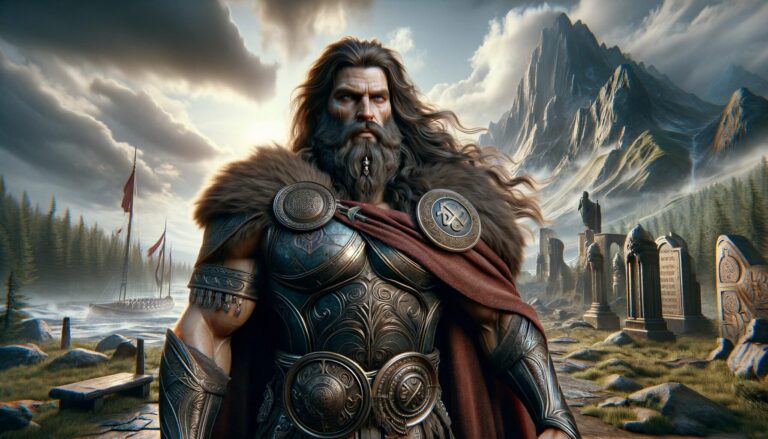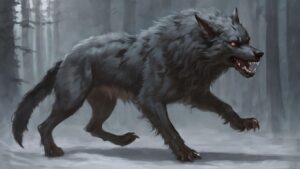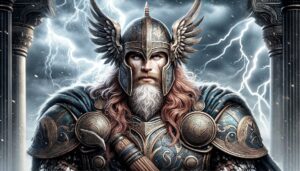Table of Contents
Tyr, often referred to as the Norse God of Law and Justice, is a captivating figure in Norse mythology. He stands as one of the Aesir, the principal group of deities in Norse cosmology, and possesses a rich history intertwined with both his family and his role in the Norse pantheon. In this exploration, we will delve deep into the mythological origins of Tyr, his family ties, distinctive appearance, unique abilities, the symbols representing him, and the intriguing myths and stories associated with this remarkable deity.
Origins
Tyr’s origins have their roots in the ancient Norse myths, and his name derives from the Old Norse word “Týr,” signifying ‘god’ or ‘deity.’ He stands as one of the older gods in the Norse pantheon, with his roots tracing back to the Proto-Germanic god Tiwaz. His name also carries a striking resemblance to the Roman god of war, Mars, emphasizing the connection between courage and justice in his domain.
Family Ties
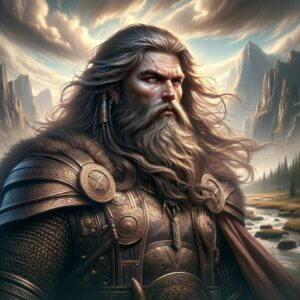
Tyr’s family connections within Norse mythology are intriguing. He is often regarded as the son of Odin, the Allfather, and Frigg, the Queen of the Aesir. This makes him a direct descendant of the ruling deities of the Norse pantheon. However, Tyr’s most notable familial relationship is with his monstrous half-brother, Fenrir the wolf.
The gods bound Fenrir, a monstrous wolf and harbinger of doom, due to a prophecy predicting his role in the Ragnarök, the apocalyptic battle that would ultimately bring about the end of the world. Tyr played a pivotal role in this dramatic tale, as he was the only one brave enough to approach Fenrir and place his hand in the wolf’s mouth as a pledge of good faith when the gods tried to bind Fenrir. This act of courage and self-sacrifice showcases Tyr’s unwavering commitment to justice, even in the face of immense danger.
Appearance
Tyr often embodies the portrayal of a strong and valiant god, mirroring the typical image of a Norse warrior with his well-built and imposing physique. Depictions of him commonly show him wearing armor and wielding a sword or spear, symbolizing his role as a god of war and valor.
One distinctive feature of Tyr’s appearance is his missing right hand. This physical attribute is the result of the aforementioned binding of Fenrir. During the binding, Fenrir bit off Tyr’s hand when he realized he was tricked. This loss of a hand serves as a powerful symbol of sacrifice for the greater good and underscores Tyr’s unwavering commitment to maintaining order and justice in the Norse cosmos.
Abilities
Tyr’s divine role as the Norse God of Law and Justice intricately ties his abilities. In the realm of law, he exhibits unparalleled wisdom and unerring fairness, making him the ultimate arbiter in legal matters and the binding of oaths. Tyr subjects those who invoke his name while swearing an oath to the strictest standards of honor and truth. He ensures that justice unwaveringly serves and imposes dire consequences for any transgression of such an oath.
However, Tyr’s capabilities transcend his embodiment of justice. As a god of war, he possesses an extraordinary mastery of combat skills, coupled with an unshakable fearlessness that knows no equal on the battlefield. His reputation for valor precedes him, earning him the utmost respect not only among warriors but also within the ranks of leaders and rulers. It is through his martial prowess and unwavering commitment to maintaining cosmic order that Tyr emerges as a revered figure, not only for his role in the realm of justice but also for his indispensable contributions to the preservation of balance and harmony in the Norse cosmos.
Symbology
Tyr is symbolized by several distinctive motifs and symbols:
- The Rune Tiwaz (ᛏ): This rune bears Tyr’s name and symbolizes honor, justice, and courage. It frequently links to the notion of making sacrifices for a just cause, echoing Tyr’s act of sacrificing his hand to bind Fenrir.
- The Sword: As a god of war and valor, the sword is a prominent symbol of Tyr. It represents his martial prowess and his role in defending the realms of the gods against chaos and destruction.
- The Scales of Justice: These scales symbolize Tyr’s role as a god of law and justice. They highlight the importance of fair judgment and maintaining order in the Norse cosmos.
Myths and Stories
The Binding of Fenrir
This is one of the most famous stories featuring Tyr. Fenrir is a monstrous wolf, one of the children of the god Loki. As Fenrir grew larger and more dangerous, the gods became concerned about his potential threat. They decided to bind him to prevent him from causing harm. They initially tried to bind Fenrir with various unbreakable chains, but he broke free from them all. Finally, the gods enlisted the help of the dwarves to create a magical chain called Gleipnir. Tyr was the only one brave enough to place his hand in Fenrir’s mouth as a gesture of trust while the wolf was being bound. When Fenrir realized he couldn’t break Gleipnir, he bit off Tyr’s hand in anger. This myth demonstrates Tyr’s courage and willingness to make personal sacrifices for the greater good.
The Mead of Poetry
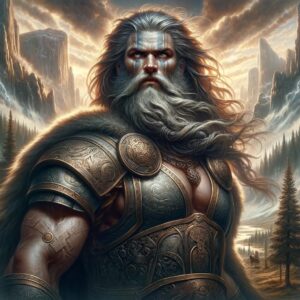
This story involves the quest to obtain the Mead of Poetry, a magical beverage with the power to grant eloquence and wisdom. The mead was guarded by the giant Suttungr. Tyr, along with Odin and other gods, wanted to secure this mead for the benefit of all beings. In the end, Odin successfully tricked Suttungr and obtained the mead, but Tyr’s involvement in this quest underscores his pursuit of knowledge and wisdom, as well as his role in the gods’ efforts to enhance the well-being of mortals through the acquisition of valuable assets.
Role in the Struggle Against Chaos
Tyr is also known for his role in the broader context of Norse mythology, where he represents order, law, and justice. He stands with the other gods in their ongoing conflict against the chaotic forces of giants, monsters, and other creatures that threaten the stability of the cosmos. His dedication to upholding cosmic order and justice makes him an important figure in maintaining the balance between order and chaos in the Norse mythology.
Relationships
In Norse mythology, Tyr had various relationships with both gods and beings considered enemies of the gods. Here’s a breakdown of some of his friends and enemies:
Friends and Allies
Odin: Tyr had a close relationship with Odin, the chief of the Norse gods. They often worked together to maintain order in the cosmos and face threats from giants and other chaotic forces.
Thor: Tyr and Thor were also close allies. They shared a common goal of protecting the gods and humanity from the giants and other dangerous beings. Tyr’s courage and Thor’s strength complemented each other in their endeavors.
Freyr: Tyr was generally on good terms with Freyr, the god of fertility and agriculture. Together with Freyr, he played a role in some of the myths involving giants and conflicts.
Enemies
Fenrir: Perhaps Tyr’s most notable enemy was Fenrir, the monstrous wolf. Although Tyr played a crucial role in binding Fenrir, it was ultimately an act of necessity to prevent the wolf from wreaking havoc on the world. Fenrir’s imprisonment came at a great cost to Tyr, as he lost his hand in the process.
The Giants: In Norse mythology, the gods often depicted giants (Jotnar) as their enemies. Given his role as a god of law and order, Tyr would have opposed the chaotic and disruptive nature of many giants. He likely participated in battles and conflicts against these giants to protect the realm of the gods and the world of mortals.
Loki: While Tyr and Loki didn’t have a direct enmity, Loki’s trickster nature often led to conflicts and disruptions in the realm of the gods. Tyr may have been involved in dealing with the consequences of Loki’s actions and ensuring justice was served.
It’s important to note that Norse mythology brims with complex and interconnected relationships, and allegiances could shift depending on the circumstances. Tyr, as a god of law and justice, would generally support the gods in their efforts to maintain order, but he also displayed a willingness to make personal sacrifices for the greater good when necessary.
Cultural Impact

Tyr’s character and attributes have had a lasting impact on Norse and Viking culture. In the warrior society of the Vikings, Tyr was revered as a god of bravery and honor. Warriors would invoke his name before battle, seeking his protection and guidance in the midst of conflict.
Moreover, Tyr’s association with law and justice left a mark on the legal systems of ancient Scandinavia. The Norse Thing, a legal assembly where disputes were resolved and judgments were made, often invoked Tyr’s name as a symbol of impartial justice.
In contemporary culture, Tyr continues to be a source of fascination and inspiration. His character appears in various forms in literature, art, and popular culture, reminding us of the enduring legacy of Norse mythology and its rich tapestry of gods and legends.
Thematic Exploration
Tyr’s character embodies several profound themes that continue to resonate with audiences today. These themes include:
Firstly, Justice and Sacrifice: Tyr’s willingness to sacrifice his hand to bind Fenrir exemplifies the theme of personal sacrifice for the greater good. Moreover, it underscores the importance of upholding justice and order, even in the face of personal loss.
Secondly, Valor and Courage: As a god of war, Tyr symbolizes the bravery and valor required to confront challenges and adversaries. His presence serves as a reminder of the courage needed to stand up for what is right.
Lastly, Wisdom and Knowledge: Tyr’s involvement in the quest for the Mead of Poetry reflects the pursuit of wisdom and knowledge. His character encourages us to seek enlightenment and understanding in our own journeys.
FAQ
What is Tyr's most famous myth?
Tyr is renowned for his role in the binding of Fenrir, the monstrous wolf.
What does Tyr symbolize?
Tyr symbolizes honor, bravery, and the pursuit of justice.
Why did Tyr sacrifice his hand?
Tyr sacrificed his hand to bind Fenrir, preventing the wolf from causing harm.
What does the Tyr rune represent?
The Tyr rune represents honor, justice, and courage in Norse mythology.
Who were Tyr's allies among the Norse gods?
Tyr had close relationships with Odin and Thor, among others.
Who were some of Tyr's enemies?
Some of Tyr's enemies included Fenrir, giants, and chaotic forces.
What role did Tyr play in the Mead of Poetry myth?
Tyr was involved in the quest to obtain the Mead of Poetry, showcasing his pursuit of wisdom and knowledge.
What are the main themes associated with Tyr's character?
The main themes associated with Tyr are justice, sacrifice, valor, courage, wisdom, and knowledge.
Why is Tyr an important figure in Norse mythology?
Tyr is important for maintaining order and upholding cosmic justice in Norse mythology.
